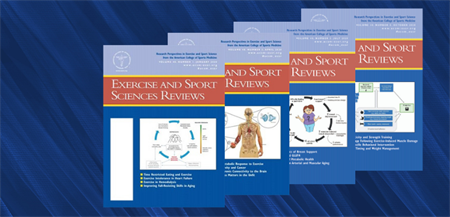Roger M. Enoka, Ph.D. |
Jan.
4, 2021
 The mission of Exercise and Sport Sciences Reviews (ESSR) is to provide forward-thinking reviews on contemporary issues that are of interest to members of ACSM. The journal publishes four issues each year: available by January, April, July and October. The charge to feature forward-thinking content is accomplished by inviting authors to provide either the rationale for a novel hypothesis or to summarize work on a contemporary issue and identify the key gaps in knowledge that need to be addressed to move the field forward.
The mission of Exercise and Sport Sciences Reviews (ESSR) is to provide forward-thinking reviews on contemporary issues that are of interest to members of ACSM. The journal publishes four issues each year: available by January, April, July and October. The charge to feature forward-thinking content is accomplished by inviting authors to provide either the rationale for a novel hypothesis or to summarize work on a contemporary issue and identify the key gaps in knowledge that need to be addressed to move the field forward.
The extent to which we achieve our mission can be assessed with two metrics: one related to the number of times the content is either read (viewed) or mentioned and one that reports the relative citation count of the published articles. Our articles can be accessed and read either through an institutional subscription to the journal (Ovid) or through the ACSM website. Typically, the read count (Ovid + ACSM) is greater for articles that were published in the years preceding a current year. This year, however, an article published in 2020 (January issue) achieved the highest read count for the year: A Time to Eat and a Time to Exercise. The article with the second greatest read count was published in 2019 on the topic of exercise and the gut microbiome. The topics of other articles (year of publication) with high read counts in 2020 were the biomechanics of breast support for active women (2020), physical activity for cancer patients (2020), protective effects of exercise in older adults (2018), syncing exercise with meals and circadian clocks (2019), sedentary behaviors and depression (2020), altitude training for exercise performance (2018), vascular and muscular benefits of exercise training in older adults (2020) and exercise intolerance in heart failure (2020).
Two articles published in 2020 were among the top 20 in the mention count (Altmetric score): A Time to Eat and a Time to Exercise (#8; January) and Consistent Morning Exercise May Be Beneficial for Individuals With Obesity (#16; October). The most-mentioned paper was on exercise and the gut microbiome (2019), followed by too much sitting (2010). These two papers had twice as many mentions as the third-ranked paper.
The other metric that indicates the relative influence of our articles is the impact factor, which provides a normalized citation count by calculating the ratio between the number of times articles were cited in a two-year period relative to the number of articles published by a journal in that period. As a measure of our recent performance, we typically count the number of citations for the articles we published in 2018-2019. As these data are not available until the summer, I have used the number of mentions (Altmetric score) to identify that most impactful articles. The article with the most mentions (676) was on the topic of exercise and the gut microbiome with the second highest count (262) being for an article on the protective effects of exercise on cognition and brain health in older adults. These top two articles were followed by a cluster of three articles with a similar mention count (104-165); the topics of these articles (in order) were the panacea of human aging, modeling overuse injuries in sport as a mechanical fatigue phenomenon and raising an active and healthy generation.
Each year, ESSR publishes ~27 articles. So far for 2021, we have published seven articles in the January issue and have another 32 articles in various stages of development for the three remaining issues for 2021 and into 2022. The topics of these articles being prepared for publication are distributed across nine of the historical 11 topic areas for the annual ACSM meeting. The topic areas with the greatest numbers of prospective articles are (1) Skeletal Muscle, Bone and Connective Tissue; (2) Biomechanics and Neural Control; and (3) Physical Activity/Health Promotion. Among these articles to be published in 2021 are 11 Perspectives for Progress, which are written by senior investigators and include the following topics:
- Strength training: in search of optimal strategies to maximize neuromuscular performance
- The interaction between mobility status and exercise specificity in older adults
- Physical activity and male reproductive function: a new role for gamete mitochondria
- Exercise is muscle mitochondria medicine
- Importance of cardiac functional remodeling to physical activity for optimization of orthostatic intolerance
- Exercise as medicine during the course of hip osteoarthritis
- The impact of insulin in cardiovascular control during exercise in diabetes
- Exercise with a challenge improves your brain
- Stepping back to minimal footwear: applications across the lifespan
- Ballistic motor learning as a unique form of motor skill learning
- Skeletal muscle nitrate as a regulator of systemic nitric oxide homeostasis and muscle function
Other articles that are likely to generate notable interest are on the topics of massage as mechanotherapy, strategies to optimize physical activity interventions, skeletal muscle capillarization to optimize satellite cell responses, sarcopenia related to HIV, negative effects of a high fat diet, exercise rehabilitation in multiple sclerosis, motor unit remodeling in older adults and master athletes, breast cancer and skeletal muscle quality, neuromodulation as a restorative approach for rehabilitation, exercising the sleeping brain, pain relief does not ensure recovery after Achilles tendinopathy and the influence of cardiorespiratory fitness and exercise intensity on exercise blood pressure. We hope our content will continue to be of interest to you and, as always, encourage you to send us suggestions on topics and authors we should consider for inclusion in the journal.
 Roger M. Enoka, Ph.D., is a professor of integrative physiology at the University of Colorado Boulder. He is the current Editor-in-Chief of Exercise and Sport Sciences Reviews (ESSR).
Roger M. Enoka, Ph.D., is a professor of integrative physiology at the University of Colorado Boulder. He is the current Editor-in-Chief of Exercise and Sport Sciences Reviews (ESSR).